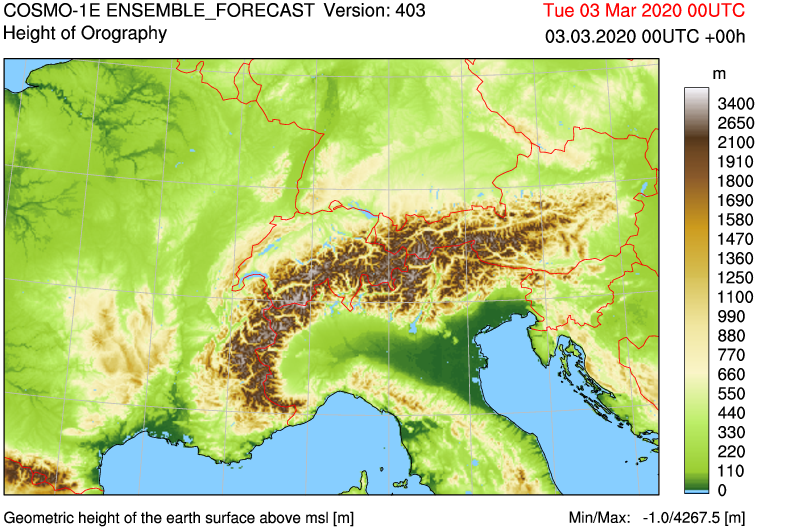
Last updated: 4 Feb 2021
Contents
MeteoSwiss operates the two ensemble forecasting systems COSMO-1E and COSMO-2E. They provide probabilistic forecasts for the Alpine region, with Switzerland at the centre of the model domain, at horizontal resolutions of 1.1 and 2.2 km, respectively.
The ensemble forecasting system COSMO-1E consists of 11 members.
Its model area extends horizontally over 1170 x 786 grid points with a grid box size of 1.1 km (0.01o), and vertically comprises 80 layers. The model topography reaches 4,268 m above sea level at its highest point.
Forecast products are available within a slightly smaller domain of only 1075 x 691 grid points, which excludes the boundary line that is unusable due to boundary effects. Its corner points are:
49.52o N, 0.16o E (NW) / 49.73o N, 16.75o E (NE) / 42.67o N, 1.33o E (SW) / 42.85o N, 15.94o E (SE).

Fig. 1. COSMO-1E domain and orography.
COSMO-1E forecasts are computed eight times a day, starting at 00, 03, …, 21 UTC. The 03 UTC forecast extends to a lead time of 45 h, all other forecasts are stopped after 33 h.
The control run is driven by boundary conditions from ECMWF HRES. The boundary conditions for the perturbed members originate from ECMWF ENS.
The initial conditions are provided by the KENDA (Km-Scale-Ensemble-Based Data Assimilation) data assimilation system. KENDA is based on the Local Ensemble Transform Kalman Filter (LETKF) technique. The KENDA ensemble consists of 40 members and runs at a mesh-size of 1.1 km.
The KENDA System currently uses measurements from the stations in the ground-level monitoring network, from radiosoundings, aircraft reconnaissance (AMDAR and MODE-S), wind profiler data, and notifications from shipping vessels and buoys. Furthermore, latent heat nudging is active during the integration of the KENDA ensemble and during the first hour of the COSMO-1E forecast.
At 11 UTC the ECMWF HRES sea surface temperature and ozone mass mixing ratio, and the MeteoSwiss snow analysis (temperature and water content) are merged into the KENDA analysis.
The KENDA assimilation cycle is updated in steps of 1h.
COSMO-1E perturbations originate from the following sources:
The ensemble forecasting system COSMO-2E consists of 21 members.
Its model area extends horizontally over 582 x 390 grid points with a grid box size of 2.2 km (0.02o), and vertically comprises 60 layers. The model topography reaches 3,867 m above sea level at its highest point.
Forecast products are available for the same domain as for COSMO-1E, representing 538 x 346 grid points.
COSMO-2E forecasts are calculated up to a lead time of 120 h four times a day, starting at 00, 06, 12, and 18 UTC.
The boundary conditions for all members are provided by ECMWF ENS.
Initial conditions are interpolated from the KENDA analyses by upscaling from the 1.1 km / 80 layers grid to 2.2 km / 60 layers. Latent-heat nudging is active during the first two hours of the forecast.
COSMO-2E perturbations originate from the same sources as for COSMO-1E.
The table below provides the namelists of INT2LM (version 2.7.1) and COSMO (version 5.07.mch1.0.p12), which are used in the operational production of COSMO-1E and COSMO-2E (ensemble member 1).
| Model | Interpolation | Integration |
|---|---|---|
| COSMO-1E | INT2LM | COSMO |
| COSMO-2E | INT2LM | COSMO |
The operational production of MeteoSwiss runs on the Cray CS-STORM system Pigne d'Arolla at the Swiss National Supercomputing Centre (CSCS) in Lugano. It consists of the two partitions Arolla and Tsa, providing production and R&D, plus failover services. A detailed list of their infrastructure components can be found on the dedicated web pages of CSCS.